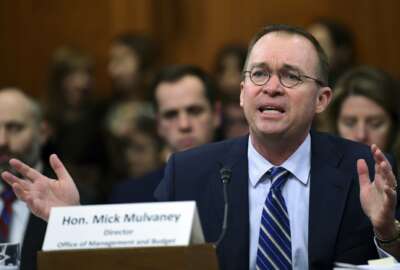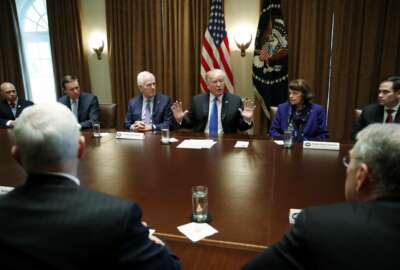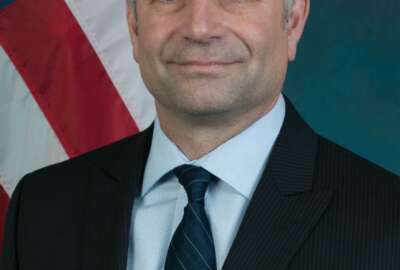
OMB shows its IT policy hand in 2019 budget request
The White House plans to give IT modernization efforts a boost through Technology Business Management (TBM) standards.
Office of Management and Budget Director Mick Mulvaney may have said it best during his Feb. 12 press conference about the fiscal 2019 budget request: “I’m going to deal, up front, with the question that everybody wants to ask — and I don’t know who would’ve gotten a chance to ask it first — is this dead on arrival? That’s the popular question that everybody asks. In fact, they were asking it this morning on television. And the answer is absolutely not. It simply highlights the fact that this is a messaging document. The executive budget has always been a messaging document.”
And that is no more true than in the world of federal IT. The actual requests for federal IT spending are nice to know, but OMB has used the budget process over the last 15 years to publicize to agencies and contractors their policy priorities.
A perfect example in OMB’s prospectus on federal IT is around IT modernization where the administration is requesting $210 million for the Technology Modernization Fund.
But if you dig deeper into that section, you will find out how OMB plans to turn that $210 million request into an IT modernization progress.
“In fiscal 2019, the administration will continue driving federal governmentwide adoption of the Technology Business Management (TBM) framework and release implementation guidance to agencies,” OMB writes in the budget section on IT. “This will increase the strategic value of IT and empower chief information officers (CIOs) to better support agency missions through more effective IT management. The TBM framework is a powerful tool that can enhance Federal Information Technology Acquisition Reform Act (FITARA) implementation by helping agency CIOs better understand, manage and demonstrate value from the money spent on IT resources. This will also help the government benchmark IT spending, improve acquisitions and procurement practices, and better understand IT investment costs, providing an opportunity to improve budgeting for IT.”
The General Services Administration requested $1.5 million to help pay for four full-time employees to create a TBM program management office to help with the further implementation by coordinating across the government.
Todd Tucker, the vice president of research, standards and education for the TBM Council, said a small office of just four employees can have a big impact.
“We’ve seen this with Washington State where a small group in the central technology services who are responsible for the program. They worked with about 44 agencies and have done amazing things to adopt TBM and make better decisions,” Tucker said. “Many times it’s more complicated than it should be when it comes to using TBM. It’s an analytics driven exercise where you are using data sets to understand the costs of IT services or applications.”
In the federal sector, the Education Department is one agency that is ahead of the pack in using TBM.
Jason Gray, the Education CIO, said the TBM tool to ingest data received its authority to operate recently.
“We are configuring it and tweaking it so the tool provides reports and information that we need,” Gray said. “We have a core financial management system that falls under the CIO, so we have all the data sets we need to get started. A lot of the effort will be tweaking the data fields and tables and making sure it’s giving us what we want. We know it is an iterative process and we may need more granularity.”
Gray said he’s starting with TBM by applying TBM standards to his $120 million budget, and then over time as they improve the processes, Education will expand the use of TBM to other spending data.
“Over the last 2 ½ months since we started, we have our ‘to-be’ environment done and the cost transparency of what we are spending money on,” he said. “The next phase is making smarter and more efficient decisions to save money, reduce risk and make sure our systems are the right systems. Then, the third phase is going into more of a value-add where we will make sure every single system is providing value add to the department. We want to directly tie the cost to what is spent to what is performed and demonstrated value. I see our phased approach to TBM.”
Tucker pointed to Education, GSA and the Environmental Protection Agency as a few of the agencies that are taking advantage of TBM already.
But GSA’s program management office could help those agencies that are just in the initial stages.
“We would love to see GSA start establishing some TBM-related services that other agencies could benefit from,” Tucker said. “Whether it is delivering TBM analytics for other agencies or professional services to help those agencies adopt it on their own or improve what they have in place, there is a lot that this small team can do.”
Tucker added over the last year the council trained 400 employees or contractors for federal agencies from every civilian and Defense agency at the departmental level and many components.
“It’s been really good to see that kind of traction, education and awareness,” he said. “That’s not adoption, but there are many who have engaged in TBM. There is a community of practice as well that was established for TBM through the CIO Council.”
MGT and IT dashboard changes
Through the budget, OMB also detailed initial guidance for the Modernizing Government Technology (MGT) Act.
“The TMF pioneers a new model for federal technology modernization projects. Agencies must apply to and compete for TMF funds,” the budget request states. “Effective evaluation, selection, and monitoring of approved projects by the TMF board will provide strong incentives for agencies to develop comprehensive, high quality modernization plans. Agencies will provide plans that meet key criteria defined by the TMF board, which will likely include: having a high probability of success, a strong team, and a substantial impact on mission and citizen service delivery. Funds will be distributed in an incremental manner, tied to milestones and objectives.”
Part of that $210 million request is for $1.4 million for a MGT program office with six employees.
While there is much uncertainty around the $210 million request — Congress hasn’t yet supported the $228 million request for fiscal 2018 — the value of the MGT Act will come from each agency’s working capital fund.
Education’s Gray said while the agency has to wait for further OMB guidance before setting up its fund, he knows there is money to be found.
“We have looked for extra funding and the opportunities to do modernization without additional funding. We have numerous systems with development, modernization and enhancement efforts ongoing and now we have a picture of those efforts. For example, should we really be spending money to enhance five systems when we could take enhancement funding from four systems and put them into one and then sunset the other four systems? I had a meeting a few weeks ago with our CFO, so we’ve have had some discussions internally. I think we are closely aligned with what we need to do to leverage the MGT Act.”
Gray said Education also was one of several agencies who participated in a pilot program of sorts with OMB for how to apply for the centralized fund.
He said Education went to OMB a few weeks ago to discuss its opportunities for modernization.
“Now that we have a complete and comprehensive view of our ‘as-is’ environment, we can visually show, for instance, how we are using the cloud,” Gray said. “We have a contractor-owned, contractor-operated externally hosted commercial and government cloud environment. Through this system assessment and visualization, it showed me the breadth of the cloud we have and the opportunities to consolidate.”
Gray said if Education can reduce and consolidate the number of cloud services it’s using, he could use that money for other modernization projects as well as reduce the threat of cyber attacks.
The spirit and intent of the MGT Act is to get agencies to stop spending so much on legacy systems. OMB estimated in budget request that spending on operations and maintenance will rise to 80 percent next year.
But more importantly, federal IT programs are experiencing more challenges.
“The IT Dashboard shows slight decreases in the general health of IT investments across government, as denoted by the decreased proportion of CIO-rated “Green” (“Low Risk” to “Moderately Low Risk”) investments on the IT Dashboard, which comprised 58 percent of all rated investments in 2018 compared to 79 percent in 2012 (assessments based on total life cycle of investments),” the budget states.
Acquisition Services Fund to rise
GSA expects agencies to spend more money through its schedules and assisted acquisition services program in 2019, and that in turn could give a boost to the IT modernization initiatives.
So much so that it is alerting Congress that it expects the ASF to increase by $536 million to $13.2 billion, and 132 more employees for a total of 3,454 above 2018 levels.
GSA says it expects agencies to spend $712 million more on assisted acquisitions and $11 million more related to increased use of the Human Capital and Training Solutions (HCaTS) governmentwide acquisition contract and the continued implementation of the One Acquisition Solution for Integrated Services (OASIS) GWAC.
GSA also expects the Technology Transformation Service, including the 18F organization, to move into the black with $447,000 of net operating revenue. This comes after TTS is expected to have lost more than $12 million in 2017 and $2.8 million in 2018. The GSA IG reported in 2016 that 18F wouldn’t cover its expenses until 2019 and lost about $32 million between 2014 and 2016.
GSA said it expects to spend $10.8 million on 18F in 2018 and $10 million in 2019.
TTS and 18F are slated to play important roles in the administration’s IT modernization effort, including creating Centers of Excellence that, like 18F, will be fee-for-service organizations dependent on the ASF for startup funding.
“GSA has implemented significant changes in the management approach for 18F to improve the operations of individual business units and TTS as a whole. In addition, TTS has implemented all OIG recommendations,” GSA wrote in its budget justification document. “The Federal Acquisition Service is monitoring the pipeline of actual and potential work orders to ensure that expenses are managed and the workforce is utilized efficiently. Resources are added only when there is assurance of future work and a corresponding need for capacity expansion. Orders, pipeline status, utilization, and expenses are all closely monitored on a weekly and monthly basis. These processes are steps towards achieving cost recovery.”
GSA has used the ASF to build up and support TTS and 18F, and now as the Centers of Excellence effort get started it will be interesting to see whether the administration decides to use these funds as startup capital, especially considering the ASF is expected to grow in 2019.
Read more of the Reporter’s Notebook.
Copyright © 2024 Federal News Network. All rights reserved. This website is not intended for users located within the European Economic Area.
Jason Miller is executive editor of Federal News Network and directs news coverage on the people, policy and programs of the federal government.
Follow @jmillerWFED






